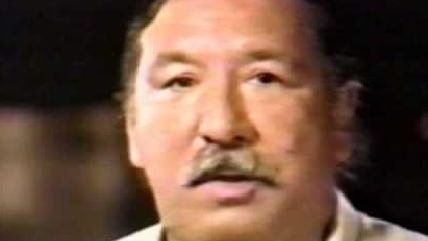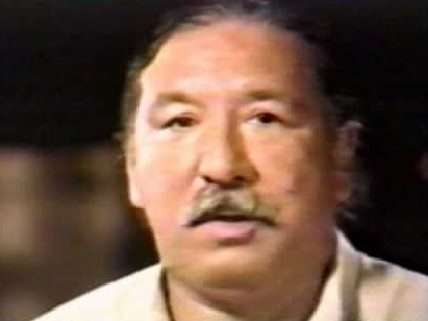40th Anniversary of Pine Ridge Shootout
Leonard Peltier serving a life sentence for the murder of two FBI agents on Pine Ridge reservation in 1975.


Today is the 40th anniversary of the June 26, 1975, shootout at Pine Ridge Reservation in South Dakota between two FBI agents who drove in with unmarked cars and several members of the American Indian Movement (AIM), a Native American rights group operating out of the reservation at the time. Both FBI agents were wounded by gunfire before appearing to be shot execution-style, and a member of AIM, Joseph Stuntz, was also fatally shot. The FBI never investigated his killing but reports he was "apparently shot by a law enforcement officer at the scene" during the shootout.
Despite having a population of just 12,000, there were more murders in Pine Ridge in the two years before the shootout than in the rest of the state of South Dakota combined. Three years ago, the FBI resolved to reinvestigate 45 homicides contemporary tribal leaders say remain unresolved. In the 1970s, many of the unsolved murders were attributed to the "Guardians of the Oglala Nation" (GOON) squad, a vigilante-like group organized by the tribal chair, Dick Wilson. AIM and others blamed Wilson, a "progressive" (as opposed to the "traditionalists" of the AIM), for the campaign against "traditional people," and accused him of widespread corruption, not uncommon in tribal governments at the time.
The two FBI special agents who entered Pine Ridge in June 1975, Jack Coler and Ronald Williams, were apparently following a Native American teenager, and member of AIM, accused of stealing a pair of cowboy boots after a fight off the reservation. Forensic evidence from the scene suggested the agents were outmanned and outgunned during the confrontation. All the AIM participants were able to flee the area despite the arrival of more federal authorities on the scene. Leonard Peltier, an AIM member, was eventually identified as a suspect in the shooting. Authorities also arrested Robert Robideau and Dean Butler, two other members of AIM, after their car, full of ammo and weapons, exploded on a highway in Kansas.
The two were tried in federal court in Cedar Rapids, Iowa, while Peltier was able to flee to Canada. Robideau and Butler were found not guilty after lawyers argued they shot the FBI agents in self-defense—both men said they didn't know Coler and Williams were FBI agents and were simply defending themselves from intruder in an environment they compared to a "war zone."
Peltier was extradited from Canada based on an affidavit his attorneys argued was not credible. The affidavit contained the testimony of Myrtle Poor Bear, who later said the FBI coerced her into making statements to incriminate Peltier—two other affidavits appeared to contradict those statements. Poor Bear could not testify at trial—the prosecutor in the case decided she was incompetent due to "obvious mental deterioration prior to trial." After losing the Cedar Rapids trial, the FBI studied the case and found that the jury wanted more evidence that the people the government was prosecuting were the ones to actually fatally shoot the FBI agents. At the Fargo, N.D., trial of Leonard Peltier, government prosecutors argued exactly that, using forensic evidence tying a casing found in the trunk of the FBI car to an AR-15 found in the explosion in Kansas, which they tied to Peltier, the only person on the scene on June 26 that, according to the FBI, had an AR-15. Peltier's lawyers questioned the forensics—they also questioned the veracity of two of the government's witnesses, who both recanted their testimony and claimed the FBI coerced them into it after the trial. The government did not lose twice—securing a conviction in the Peltier case. Prosecutors were helped by the fortuitous evidence not available at the previous trial, and also by the fact that the jury was not allowed to hear about previous cases of FBI witness and evidence tampering, something other juries in similar trials, including the Cedar Rapids trial, were able to hear.
Peltier was sentenced to two consecutive life sentences. He's been denied parole a number of times—his next parole hearing isn't until 2024 and his expected release date is 2040, when Peltier would be 96. Many people expected Bill Clinton to grant Peltier clemency before the end of his term. He didn't. Neither did George W. Bush at the end of his. In 2007, media mogul David Geffen, a big Democratic fundraiser/supporter, backed Barack Obama over Hillary Clinton in part because of Clinton's failure to pardon Peltier. Geffen had led an effort in 2000 to secure a last minute clemency for Peltier. Clinton issued 140 pardons, including one for financier Marc Rich, a big Clinton donor, but not for Peltier. Obama, who ended up winning that presidential election, has as yet not granted clemency to Peltier either, nor indicated that he would. Earlier this week the White House tweeted about Pine Ridge, not about Peltier or the shooting but about a new clean energy project being funded by the federal government on the reservation. That article includes a thoroughly depressing quote from the executive director of the Community Development Corporation responsible for the project. "Today is the beginning of the end of poverty on Pine Ridge," Nick Tilsen said at the groundbreaking. But poverty was the overwhelming problem in Pine Ridge 40 years ago when the shootout happened, and the 40 years before that, and the 40 years before that, when the feds first established Pine Ridge as a reservation for Native Americans to go to stagnate. The issue of government malfeasance toward Native Americans isn't one that would be out of place in the contemporary civil rights milieu—Native Americans are most likely to be killed in encounters with police.
Related: Reason interviewed Russell Means, one of the first members of AIM, who became a prominent libertarian activist, in our August/September 1986 issue (PDF).
Read the FBI's fact sheet on the shooutout and subsequent cases here.



Show Comments (55)